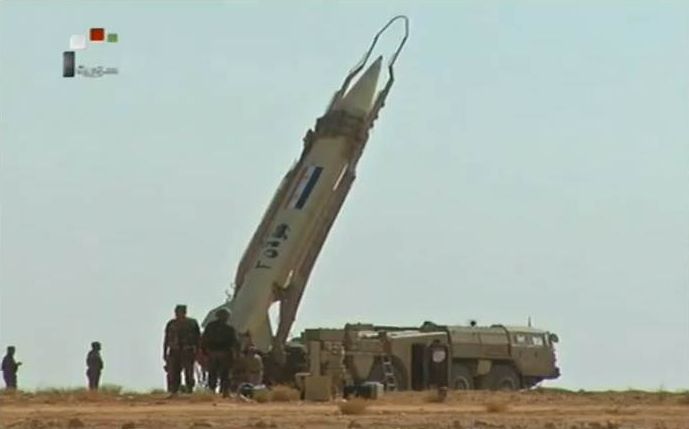
From Samia Nakhoul and Khaled Yacoub Oweis, Reuters: Syrian President Bashar al-Assad’s forces have fired Scud-style ballistic missiles against rebels in recent days, U.S. and NATO officials said on Wednesday, in what U.S. officials described as an escalation in the 20-month civil war.
The United States, European powers and Arab states bestowed their official blessing on Syria’s newly-formed opposition coalition on Wednesday, despite increasing signs of Western unease at the rise of militant Islamists in the rebel ranks.
Rebels battled Assad’s troops on the outskirts of his Damascus power base. Their advances in the past two weeks have prompted their international allies to talk of the 20-month-old conflict finally entering a decisive phase. . . .
"Allied intelligence, surveillance and reconnaissance assets have detected the launch of a number of unguided, short-range ballistic missiles inside Syria this week," said a NATO official in Brussels. "Trajectory and distance travelled indicate they were Scud-type missiles."
A U.S. official, speaking on condition of anonymity, confirmed the use of Scuds. U.S. officials said they were not aware of any previous uses of the missiles.
It was not immediately clear why Assad’s forces would deploy Scuds, which can have a range of up to a few hundred km and are best-known internationally from the 1991 Gulf War when Iraqi leader Saddam Hussein fired them at Israel.
The Soviet-designed missiles are unguided and inaccurate, and are not usually seen as a weapon of choice for the sort of internal anti-guerrilla war that the government is waging against small, mobile rebel bands.
Assad’s forces have in the past relied on artillery, helicopters and attack jets, all of which are much more useful in close urban combat. However, the lightly armed rebels are increasingly obtaining better weapons to fight back, including the ability to shoot down aircraft.
Last week NATO decided to deploy U.S., German and Dutch batteries of Patriot air defense missiles along the Turkish-Syrian border, saying its main worry was the prospect of Syrian missiles being fired across the frontier.
That decision means hundreds of U.S. and European troops being sent to the border for the first time since the war began 20 months ago. Syria and Russia called it a pretext for the Western alliance to become drawn into the war.
From Karen DeYoung and Ernesto Londoño, Washington Post: Syrian forces fired an unknown number of Scud missiles over several days within the past week at opposition targets in northeastern Syria, an administration official said. The official declined to provide specific numbers or aspects of targeting because of “intelligence reasons,” but he echoed [Jay] Carney’s language in describing the use of Scuds as an act of desperation by the Assad government.
“How desperate do you need to be to launch a ballistic missile against your own people in your own country,” the official said. “It’s the last tool you would use in a counterinsurgency…. It makes you wonder if [Assad forces] are increasingly scared to drop ordnance from aircraft because of improved capacity by opposition forces to target them.” Scuds, the official said, are “notoriously inaccurate weapons” that pose an “increased likelihood of civilian casualties.”
The official also questioned the Assad regime’s willingness to “deplete a key defensive capability like this. . . .”
A day earlier, rebels took over a large military base 15 miles west of Aleppo, the country’s commercial capital. At least 35 soldiers were killed in the heavy fighting and more than 60 were injured and captured by rebels, according to activists.
Rebel forces have taken over at least half a dozen military bases during the past two weeks, capturing new and heavier weapons at each stop and seemingly building momentum toward a decisive showdown with Assad’s forces.
From Michael R. Gordon and Eric Schmitt, New York Times: “The total is number is probably north of six now,” said another American official, adding that the targets were in areas controlled by the Free Syrian Army, the main armed insurgent group. . . .
The Obama administration views the Assad government’s use of Scud missiles as a “significant escalation” of the conflict, said a senior official. It also shows, he said, the increasing pressure on Mr. Assad, since Scuds are primarily defensive weapons, being used by the government offensively against a counterinsurgency.
“Using Scuds to target tanks or military bases is one thing,” the official said, speaking on condition of anonymity. “Using them to target rebels hiding in playgrounds at schools is something else.”
Among other repercussions the Obama administration fears is the possibility that Mr. Assad’s military could fire Scuds near, or over, the border with Turkey, which has become one of the Syrian president’s most ardent foes. That could result in Turkey firing its Patriot antimissile batteries, the administration official said. (photo: Asian Defense)
Image: asian%20defense%2012%2012%2012%20Syrian%20SCUD.jpg
